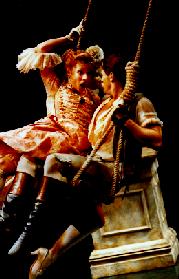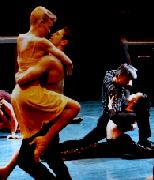Contact--a Dance Play,
|
Contact . . .Bigger Stage. . .Better Than Ever This genre-crossing musical never seemed cramped in it's original Lincoln Center space. The dancers navigated the small stage without any sense of constraint. What was tight was the seating capacity.
Now, without losing a smidgen of its intimate flavor, the dancers continue to enchant. The three stories progress from the charming curtain raiser, "Swinging" to "Did You Move?" and finally, the powerhouse finale from which the show takes its name.& The cast, the set, the costumes -- all there, as ever a feast for the eyes and making contact with the viewer's emotions despite dialogue so minimal it wouldn't even fill a page. The music is still well chosen, still "canned." This is common procedure in ballet to which this show is as closely connected as to musical theater. Musicians need hardly worry that this is the beginning of the end of live music on stage. It works for this show, but it's unlikely to start a trend.
The location and box office for the Vivian Beaumont are the same as Mitzi Newhouse  OK for ages 13 and up OK for ages 13 and up
|
Who is she? -- Michael (Boyd Gaines)
Someone who likes to dance -- the bartender in a swing club (Jason Antoon) where everyone except Michael is a spectacular dancer, especially the girl in the yellow dress who helps transform a man who stumbles unhappily through life into one who comes alive when he learns to dance -- ergo, and makes contact.
 Note the space between Boyd Gaines
and Deborah Yates in the picture that appears on the posters and Playbill
covers advertising the delectable musical that just opened at Lincoln Center's
Mitzi Newhouse Theater. The space that encases today's city dwellers and
prevents them from making contact with others is the theatrical thread
that connects its three very different dance pieces. Call it a musical,
a dance play, a theater dance piece -- by any name you choose, Contact
will dance its way into that place in your memory book reserved for
the most enjoyable, ingeniously directed and spectacularly performed theater
experiences of this or any recent season.
Note the space between Boyd Gaines
and Deborah Yates in the picture that appears on the posters and Playbill
covers advertising the delectable musical that just opened at Lincoln Center's
Mitzi Newhouse Theater. The space that encases today's city dwellers and
prevents them from making contact with others is the theatrical thread
that connects its three very different dance pieces. Call it a musical,
a dance play, a theater dance piece -- by any name you choose, Contact
will dance its way into that place in your memory book reserved for
the most enjoyable, ingeniously directed and spectacularly performed theater
experiences of this or any recent season.
I'll admit that I went feeling a tad skeptical about all the pre-opening press about the "dance play" tag. While a cast of 22 is substantial enough for a medium-sized musical, the absence of a libretto with lyrics and songs and the use of recorded music smacked suspiciously of yet another step in the trend towards "downsizing." But my skepticism disappeared the minute the Fragonard painting that dominates the Newhouse stage comes brilliantly to life in the witty, sexy opening piece, The Swing.
What director-choreographer Susan Stroman has wrought is a small gem that is outsized in every respect. It's a hybrid in the sense that Matthew Bourne's Swan Lake crossed the boundaries that separate ballet and theater. And even though it relies on the choreography to carry John Weidman's book, it is a giant step up from Fosse which is basically a revue-retrospective lacking a substantive biographical element. Weidman's dialogue is minimal, but most appropriately so.
What gives Contact its theatrical strength and originality is Ms. Stroman's savvy casting -- especially Karen Ziemba, who is finally in a show that makes full use of her dual talents as an actress and dancer; and Boyd Gaines, an actor who seems to have stumbled into this dance show. Ziemba ( in Did You Move?), brings an amazing female Walter Mitty vulnerability to a frustrated wife having dinner with a husband whose only words to her are "Don't talk. Don't smile. Don't fucking move." Whenever the husband, heads for the buffet in another room, Ziemba's prim housewife along with the restaurant staff and guests errupts into fantasy ballets that gloriously evoke the power of dance to set us free, even if only temporarily. In the last and longest story which also has the most dialogue, Gaines is a marvelously realized stumblebum. As haltingly follows the dancers at a sizzling with energy swing club and makes contact with a gorgeous, lithe-limbed dancer in a yellow dress (Deborah Yates, a spectacular newcomer), he reconnects with life. Jason Antoon who metamorphoses from Ziemba's threatening Mafia husband to the swing club's friendly bartender in the last story, is another example of the terrific actor-dancer mix.
The music, while not newly written, nevertheless makes a new statement by virtue of the choices made. The selections which range from recordings of Stephane Grappelli playing Rodgers and Hart, Grieg and Tchaikovsky to Dean Martin singing "You're Nobody Until Somebody Loves You" songs by the Beach Boys and "Sing, Sing Sing." The unexpected placement (the Rogers and Hart in the 18th century opening pastiche, the classical numbers in the low-brow Queens restaurant) add to the surprises Ms. Stroman pulls out of her dance theater Pandora's box. It's all of a piece with Contact' s blend of genres and periods (Swinging is an 18th Century soufflé of sizzling amoral intrigue, Did You Move? is circa 1954 and Contact is set in today's New York City.
Not to be overlooked in recounting Contact's treasury of riches, is Thomas Lynch's set which elegantly connects the three stories. The sculpture next to the come-to-life Fragonard painting, wittily becomes part of the schlocky decor of the Italian restaurant in part two and shrinks into Boyd Gaines' Clio in part three. There are little touches like this to savor throughout, all without taking attention from the main attraction: Ms. Stroman's brilliant choreography and the equally brilliant execution by the performers.
To close with a paraphrase of Mark Twain: Announcements about the death of inventive, enjoyable musical theater have been premature. Contact has all the earmarks of pleasing larger audiences than the tiny Mitzi Newhouse can accommodate, and if on Broadway would more than likely nab a Tony. That said, this intimate space, more than other Broadway theater I can think of, is ideally suited for maximum audience-performer contact. May it dance on there as long past its scheduled November 28th closing as possible.
LINKS
CurtainUp has reviewed a number of other theater dance pieces. Except for the first in the links below none rial the scope and genre crossing uniqueness of Contact
Swan Lake
Fosse
Vers La Flamme
A Simple Heart
| CONTACT a dance play
Part 1: Swinging stars Seán Martin Hingston, Stephanie Michels, Scott Taylor Part 2: Did You Move? stars Karen Ziemba Part 3: Contact stars Boyd Gaines Conceived by Susan Stroman and John Weidman Directed and choreographed by Susan Stroman Complete Cast (in alphabetical order): Jason Antoon, John Bolton, Tom é Cousin, Pascale Faye, Boyd Gaines, Nina Goldman, Peter Gregus, Shannon Hammons, Jack Hayes, Danny Herman, Seán Martin Hingston, Stacey Todd Holt, Angelique Ilo, David MacGillivray, Joanne Manning, Stephanie Michels, Mayumi Miguel, Dana Stackpole, Scott Taylor, Rocker Verastique, Robert Wersinger, Deborah Yates and Karen Ziemba Set Design: Thomas Lynch Lighting Design: Peter Kaczorowski Costume Design: William Ivey Long Sound Design: Scott Stauffer Associate choreographer: Chris Peterson Running time: 2 hours with one intermission between part 2 and 3 Newhouse/Lincoln Center, 150 W. 65th St. , 239-6200 Performances from 9/09/99-11-28/99; opening 10/08/99 Reviewed 10/08 by Elyse Sommer Good reviews led to a post opening day extension announcement-- with the new closing date 1/02/2000. |




